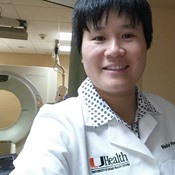Program Information
A Practical Quality Assurance Method for Radiotherapy Treatment Planning
X Li*, B Ebrahimi , Y Yang , University Of Miami, Miami, FL
Presentations
PO-BPC-Exhibit Hall-21 (Saturday, March 18, 2017) Room: Exhibit Hall
Purpose: To develop a practical method for quality assurance of EBRT planning, which can potentially improve planning quality and efficiency, by benchmarking the achievable doses in organs-at-risk (OAR) based on a model calibrated against a reference database of prostate treatment plans.
Methods: A total of 29 highly optimized clinical VMAT prostate plans (Eclipse 11.0) were studied retrospectively to generate a mathematical model for calculating achievable OAR (anorectum and bladder) doses based on the relative locations of the planning volume and OAR. Anatomical and dosimetric parameters of PTVs and OAR were obtained from the planning CT (PCT) images and clinical plans, respectively. The minimum vertical distances (d) between the PTV and OAR were measured in all PCT slices. For each OAR, six anatomical parameters, including the minimum, mean, median, and standard deviation (dmin, dmean, dmedian, dSTD, respectively), the PTV volume (Vptv), and the overlap volume ratio (OVR) as the inputs, and two dosimetric parameters, V₄₀ and V₆₅ as the outputs of the model were chosen. Singular Value Decomposition (SVD) method was used to obtain the coefficients of the model describing the achievable patient specific V₄₀ and V₆₅.
Results: The quadratic model-predicted dosimeteric parameters were in close correlation with those from the actual treatment plans (for V₄₀ and V₆₅ R=0.89 and 0.81 for anorectum, and 0.78 and 0.91 for bladder, respectively). While mean squared error (MSE) was reduced to half once quadratic terms were included in the linear model, adding higher polynomial terms did not significantly improve MSE.
Conclusion: This study presents a fast and effective quality assurance method for evaluating EBRT planning efficiency. Moreover, it shows that patient specific achievable OAR doses can be predicted based on the anatomical parameters. Finally, it offers a dosimetric benchmark in advance that can potentially benefit the clinical workflow.
Contact Email:
